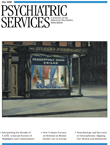Letter
Violence and Commitment to Treatment
To the Editor: The February issue of Psychiatric Services featured several articles that made contributions to our understanding of violence in mental illness. We would like to add two points to this discussion.
First, there is now good evidence that people with psychotic disorders are more likely to be violent during their first episode of psychosis than later in their illness. In our own study, 61% of 88 persons with psychotic illness who had committed homicide were experiencing a first episode of psychosis ( 1 ). We conducted a systematic review of the literature for studies that reported on homicide among persons with psychosis ( 2 ). We found that 11 of 14 studies from Western countries reported that between 30% and 50% of the lifetime risk of homicide attributable to psychosis appeared to be during the first episode of psychosis. Furthermore, our review found case linkage studies from Australia and Denmark that also indicate that most violent offending by patients with schizophrenia occurs before, or at the time of, initial treatment. Three North American publications support this finding; they reported that between 28% and 72% of people who had received a verdict of not guilty by reason of insanity after committing a variety of very serious crimes had never been hospitalized. Finally, ten clinical studies of patients experiencing their first episode of psychosis have shown that an average of 18% were physically violent and 8% committed an act of serious aggression during the first psychotic episode ( 3 ).
Second, we believe that assessment of a patient's capacity to refuse treatment, not prediction of future violence, should be the primary criterion used to determine whether the patient should receive psychiatric treatment to which he or she has not consented. Dangerousness might be a reasonable criterion for involuntary detention—for example, in a hospital—but such detention does not imply treatment nor does it always automatically permit involuntary treatment other than in an extreme emergency. Furthermore, dangerousness is not the right criterion to use for involuntary treatment.
As Buchanan ( 4 ) demonstrated in his article in the February issue, if predicted serious violence is the fulcrum for involuntary commitment, the cost of detaining one person who will become violent is the detention of 15 people who will not, even when clinicians use their best predication tools. Demanding that predicted violence be the fulcrum for involuntary treatment may also result in longer periods of nontreatment for many people with mental illness who may benefit from treatment but who lack the capacity to see themselves as ill. This is exactly what we found when we compared the duration of untreated psychosis in legislative jurisdictions that demanded the prediction of harm to self or others before involuntary treatment and in legislative jurisdictions that used other legal criteria ( 5 ).
Capacity to refuse treatment should be the fulcrum of commitment law. Moreover, "commitment" should be a commitment to treatment, not to a particular outpatient or inpatient setting. The setting should be the one that imposes the least restrictive environment upon the incompetent person with mental illness. Determining the safest, least restrictive environment is the sort of decision that is appropriately guided by our imperfect attempts to predict future violence. Earlier treatment of patients and an increased focus on assessing their capacities and providing support for any incapacities that are evident may be safer and more helpful than reliance on risk assessment to make decisions about treatment.
1. Nielssen OB, Westmore BD, Large MM, et al: Homicide during psychotic illness in New South Wales between 1993 and 2002. Medical Journal of Australia 186:301–304, 2007Google Scholar
2. Large M, Nielssen O: Evidence for a relationship between the duration of untreated psychosis and the proportion of psychotic homicides prior to treatment. Social Psychiatry and Psychiatric Epidemiology 43: 37–44, 2008Google Scholar
3. Nielssen O, Large M, Ryan CJ, et al: Legal implications of the increased risk of homicide and serious violence in the first episode of psychotic illness. Criminal Law Journal 31:287–294, 2007Google Scholar
4. Buchanan A: Risk of violence by psychiatric patients: beyond the "actuarial versus clinical" assessment debate. Psychiatric Services 59:184–190, 2008Google Scholar
5. Large M, Neilssen O, Ryan CJ, et al: Mental health acts that require dangerousness for involuntary admission may delay the initial treatment of schizophrenia. Social Psychiatry and Psychiatric Epidemiology 43: 251–256, 2008Google Scholar



